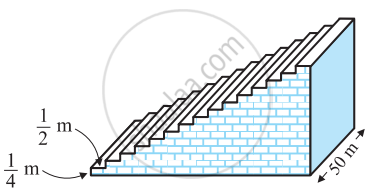Advertisements
Advertisements
प्रश्न
Write an A.P. whose first term is a and common difference is d in the following.
उत्तर
a = –7, d = `1/2`
t1 = a = –7
t2 = a + d = `-7 + 1/2 = (-14 + 1)/2 = (-13)/2`
t3 = a + 2d = `-7 + 2(1/2)` = –7 + 1 = –6
t4 = a + 3d = `-7 + 3(1/2) = -7 + 3/2 = (-14 + 3)/2 = (-11)/2`
∴ A.P. is `-7, (-13)/2, -6, (-11)/2 .......`
∴ A.P. is –7, –6.5, –6, –5.5 ........
APPEARS IN
संबंधित प्रश्न
A small terrace at a football field comprises 15 steps, each of which is 50 m long and built of solid concrete. Each step has a rise of `1/4` m and a tread of `1/2` m (See figure). Calculate the total volume of concrete required to build the terrace.
[Hint: Volume of concrete required to build the first step = `1/4 xx 1/2 xx 50 m^3`]

Which term of the progression 20, 19`1/4`,18`1/2`,17`3/4`, ... is the first negative term?
Find the sum of the following arithmetic progressions:
41, 36, 31, ... to 12 terms
Find the sum of the following arithmetic progressions:
`(x - y)/(x + y),(3x - 2y)/(x + y), (5x - 3y)/(x + y)`, .....to n terms
Find the sum of the first 13 terms of the A.P: -6, 0, 6, 12,....
Find the sum of first 51 terms of an A.P. whose 2nd and 3rd terms are 14 and 18 respectively.
Find the sum of two middle most terms of the AP `-4/3, -1 (-2)/3,..., 4 1/3.`
Find the 8th term from the end of the AP 7, 10, 13, ……, 184.
A sum of ₹2800 is to be used to award four prizes. If each prize after the first is ₹200 less than the preceding prize, find the value of each of the prizes
Find the value of x for which (x + 2), 2x, ()2x + 3) are three consecutive terms of an AP.
What is the sum of first n terms of the AP a, 3a, 5a, …..
Find the sum of first n terms of an AP whose nth term is (5 - 6n). Hence, find the sum of its first 20 terms.
Find the first term and common difference for the A.P.
0.6, 0.9, 1.2,1.5,...
The sum of first n terms of an A.P. is 5n − n2. Find the nth term of this A.P.
The first term of an A.P. is p and its common difference is q. Find its 10th term.
Let the four terms of the AP be a − 3d, a − d, a + d and a + 3d. find A.P.
Q.20
Find second and third terms of an A.P. whose first term is – 2 and the common difference is – 2.
How many terms of the AP: –15, –13, –11,... are needed to make the sum –55? Explain the reason for double answer.
An Arithmetic Progression (A.P.) has 3 as its first term. The sum of the first 8 terms is twice the sum of the first 5 terms. Find the common difference of the A.P.
